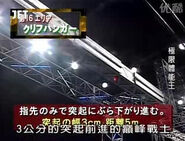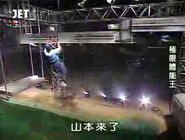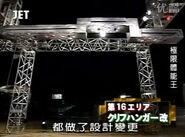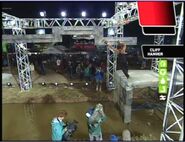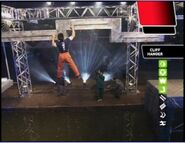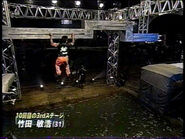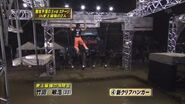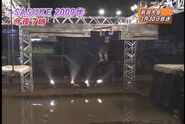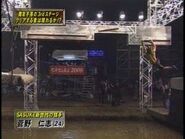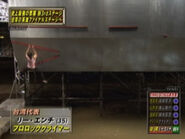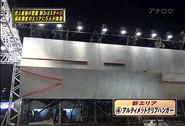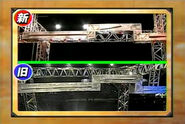No edit summary Tag: Source edit |
(Yes. As long as it is used officially, the infobox shall use the official name listed. Unofficial names/ fan-made names shall not be permitted. You yourself may refer it to the Cliffhanger Dansa, but officially it does not. Thus, it won't be.) Tag: Source edit |
||
| Line 17: | Line 17: | ||
| s_clear = [[SASUKE 4]], [[Asaoka Hiroyuki]] |
| s_clear = [[SASUKE 4]], [[Asaoka Hiroyuki]] |
||
}} |
}} |
||
| − | '''Choku Senkei Cliffhanger''' (直線型クリフハンガー, literally Cliffhanger Straight Version) is the first ever version of Cliffhanger, appearing only in [[SASUKE 4]]. In this version, all three ledges were placed at the same height and each ledge was 1.2 metres long. There are gaps present between the ledges to provide challenge, with each gap being 50 cm-long. |
+ | The full name as '''Choku Senkei Cliffhanger''' (直線型クリフハンガー, literally Cliffhanger Straight Version) is the first ever version of Cliffhanger, appearing only in [[SASUKE 4]]. In this version, all three ledges were placed at the same height and each ledge was 1.2 metres long. There are gaps present between the ledges to provide challenge, with each gap being 50 cm-long. |
| + | |||
| + | |||
[[File:Akiyama Kazuhiko attempting Cliffhanger in SASUKE 4.png|thumb|300px|left|[[Akiyama Kazuhiko]] attempting Cliffhanger in [[SASUKE 4]]]] |
[[File:Akiyama Kazuhiko attempting Cliffhanger in SASUKE 4.png|thumb|300px|left|[[Akiyama Kazuhiko]] attempting Cliffhanger in [[SASUKE 4]]]] |
||
| Line 29: | Line 31: | ||
== Second Version == |
== Second Version == |
||
{{Infobox Obstacle |
{{Infobox Obstacle |
||
| − | | name = Cliffhanger |
+ | | name = Cliffhanger |
| image = [[File:Cliffhanger Dansa (SASUKE 6).png|thumb]] |
| image = [[File:Cliffhanger Dansa (SASUKE 6).png|thumb]] |
||
| caption = Cliffhanger Dansa in [[SASUKE 6]] |
| caption = Cliffhanger Dansa in [[SASUKE 6]] |
||
| Line 40: | Line 42: | ||
| s_clear = [[SASUKE 5]], [[Yamamoto Shingo]] |
| s_clear = [[SASUKE 5]], [[Yamamoto Shingo]] |
||
}} |
}} |
||
| − | '''Cliffhanger Dansa''' (クリフハンガー段差, literally Cliffhanger with Dropout Section) is the second version of Cliffhanger, appearing from [[SASUKE 5]] to [[SASUKE 8]]. The only modification from the previous version being the third ledge was raised by 30 cm, creating a "step" to be crossed by (Dansa means "Step" in Japanese). The length of the gaps remained at 50 cm. |
+ | The full name as '''Cliffhanger Dansa''' (クリフハンガー段差, literally Cliffhanger with Dropout Section) is the second version of Cliffhanger, appearing from [[SASUKE 5]] to [[SASUKE 8]]. The only modification from the previous version being the third ledge was raised by 30 cm, creating a "step" to be crossed by (Dansa means "Step" in Japanese). The length of the gaps remained at 50 cm. |
Interestingly, the obstacle was initially named in [[SASUKE 5]] as ''Cliffhanger (Kai)'' [クリフハンガー (改)], but for unknown reasons, it was reverted to the original naming in the [[SASUKE 6|next tournament]]. The successor version adopted the name afterwards. |
Interestingly, the obstacle was initially named in [[SASUKE 5]] as ''Cliffhanger (Kai)'' [クリフハンガー (改)], but for unknown reasons, it was reverted to the original naming in the [[SASUKE 6|next tournament]]. The successor version adopted the name afterwards. |
||
| − | [[File:Cliffhanger Dansa.png|thumb|300px|left|Cliffhanger |
+ | [[File:Cliffhanger Dansa.png|thumb|300px|left|Cliffhanger being named as Cliffhanger (Kai) in [[SASUKE 5]]]] |
| − | [[File:Yamamoto Shingo attempting Cliffhanger Dansa in SASUKE 5.png|thumb|300px|left|[[Yamamoto Shingo]] attempting Cliffhanger |
+ | [[File:Yamamoto Shingo attempting Cliffhanger Dansa in SASUKE 5.png|thumb|300px|left|[[Yamamoto Shingo]] attempting Cliffhanger in [[SASUKE 5]]]] |
{{clear}} |
{{clear}} |
||
| − | [[Yamamoto Shingo]] was the only competitor to attempt this version more than once |
+ | [[Yamamoto Shingo]] was the only competitor to attempt this version more than once in [[SASUKE 5]] and [[SASUKE 7]] (both times clearing it). This version claimed at least one victim in two out of four tournaments in which it was used, with [[SASUKE 5]] and [[SASUKE 8]] being the tournaments with 100% clear rate, making it the first Cliffhanger version to have multiple tournaments with 100% clear rate. |
| − | |||
| ⚫ | |||
| ⚫ | |||
{{clear}} |
{{clear}} |
||
| Line 69: | Line 70: | ||
'''Cliffhanger Kai''' (クリフハンガー改, literally Altered Cliffhanger) is the third version of Cliffhanger, appearing from [[SASUKE 9]] to [[SASUKE 17]]. The modifications compared to the previous version being the first ledge was doubled in length to 2.4 metres (despite it being 1.2 metres in blueprint), the second ledge was raised by 30 cm, and the third ledge was lowered by 45 cm. The length of the gaps still remained at 50 cm. |
'''Cliffhanger Kai''' (クリフハンガー改, literally Altered Cliffhanger) is the third version of Cliffhanger, appearing from [[SASUKE 9]] to [[SASUKE 17]]. The modifications compared to the previous version being the first ledge was doubled in length to 2.4 metres (despite it being 1.2 metres in blueprint), the second ledge was raised by 30 cm, and the third ledge was lowered by 45 cm. The length of the gaps still remained at 50 cm. |
||
| − | So far, this version lasted the longest |
+ | So far, this version lasted the longest thus far of any versions. In later tournaments, the obstacle marked the halfway point and clearing it was a major accomplishment. |
Like [[Lamp Grasper]] which introduced in the same tournament, the distance of the obstacle to the finish platform varied from one tournament to another: |
Like [[Lamp Grasper]] which introduced in the same tournament, the distance of the obstacle to the finish platform varied from one tournament to another: |
||
| Line 102: | Line 103: | ||
Due to the large gap, in [[SASUKE 18]], [[Nagano Makoto]] was [[Nagano Makoto's Shin-Cliffhanger Disqualification|disqualified]] when he attempt to jump to the third ledge. A metal sheet was placed above the first and third ledges starting from [[SASUKE 19]] to prevent such case occured again. |
Due to the large gap, in [[SASUKE 18]], [[Nagano Makoto]] was [[Nagano Makoto's Shin-Cliffhanger Disqualification|disqualified]] when he attempt to jump to the third ledge. A metal sheet was placed above the first and third ledges starting from [[SASUKE 19]] to prevent such case occured again. |
||
| − | [[File:Nagano Makoto's Shin-Cliffhanger DQ in SASUKE 18.png|thumb|300px|left|[[Nagano Makoto]] attempting Shin-Cliffhanger in<br>[[SASUKE 18]], but disqualify himself after grabbing the top of the |
+ | [[File:Nagano Makoto's Shin-Cliffhanger DQ in SASUKE 18.png|thumb|300px|left|[[Nagano Makoto]] attempting Shin-Cliffhanger in<br>[[SASUKE 18]], but disqualify himself after grabbing the top of the obstacle]] |
| Line 154: | Line 155: | ||
{{clear}} |
{{clear}} |
||
| + | ===Modification=== |
||
[[File:Ultimate Cliffhanger (SASUKE 26).png|thumb|300px|Modified Ultimate Cliffhanger in full, as seen in [[SASUKE 26]]]] |
[[File:Ultimate Cliffhanger (SASUKE 26).png|thumb|300px|Modified Ultimate Cliffhanger in full, as seen in [[SASUKE 26]]]] |
||
[[File:Nagano Makoto attempting Ultimate Cliffhanger in SASUKE 27.png|thumb|300px|[[Nagano Makoto]] attempting Ultimate Cliffhanger in [[SASUKE 27]]]] |
[[File:Nagano Makoto attempting Ultimate Cliffhanger in SASUKE 27.png|thumb|300px|[[Nagano Makoto]] attempting Ultimate Cliffhanger in [[SASUKE 27]]]] |
||
| − | In [[SASUKE 26]], the third ledge was lowered to make the transition from the angled ledges easier, but this resulted in making the transition to the fourth ledge much harder. To compensate for what would have been a 1.2 metre gap between the third and fourth ledges, the third ledge was also lengthened slightly to make it a gap more similar to the gap between the second and third ledges of |
+ | In [[SASUKE 26]], the third ledge was lowered to make the transition from the angled ledges easier, but this resulted in making the transition to the fourth ledge much harder. To compensate for what would have been a 1.2 metre gap between the third and fourth ledges, the third ledge was also lengthened slightly to make it a gap more similar to the gap between the second and third ledges of the second version. Also, a large sheet of metal was placed at the base of the obstacle, in order to hide the metal supports that were visible in SASUKE 25. |
[[Lee En-Chih]] and [[Okuyama Yoshiyuki]], in their second attempts, made it to the end of the fourth ledge, but failed while building momentum to swing to the small fifth ledge. Two American competitors, [[Brent Steffensen]] and [[David Campbell]], also able to attempt this, however, both of them failed while trying to make a transition to the fourth ledge. |
[[Lee En-Chih]] and [[Okuyama Yoshiyuki]], in their second attempts, made it to the end of the fourth ledge, but failed while building momentum to swing to the small fifth ledge. Two American competitors, [[Brent Steffensen]] and [[David Campbell]], also able to attempt this, however, both of them failed while trying to make a transition to the fourth ledge. |
||
| Line 202: | Line 204: | ||
{{Infobox Obstacle |
{{Infobox Obstacle |
||
| name = Ultra Crazy Cliffhanger |
| name = Ultra Crazy Cliffhanger |
||
| − | | image = |
+ | | image = Ucch ssk32.png |
| caption = Ultra Crazy Cliffhanger in [[SASUKE 32]] |
| caption = Ultra Crazy Cliffhanger in [[SASUKE 32]] |
||
| s_stage = [[Third Stage]] |
| s_stage = [[Third Stage]] |
||
| Line 211: | Line 213: | ||
| s_clear = [[SASUKE 32]], [[Drew Drechsel]] |
| s_clear = [[SASUKE 32]], [[Drew Drechsel]] |
||
}} |
}} |
||
| − | '''Ultra Crazy Cliffhanger'' (ウルトラクレイジークリフハンガー) is the seventh version of Cliffhanger, appearing from [[SASUKE 32]] to [[SASUKE 36]]. Compared to previous version, there are major differences, with the number of ledges being reduced to three, |
+ | '''Ultra Crazy Cliffhanger''' (ウルトラクレイジークリフハンガー) is the seventh version of Cliffhanger, appearing from [[SASUKE 32]] to [[SASUKE 36]], revealed via Inui's Twitter account, and then in [[SASUKE 32]]'s Navi after [[Morimoto Yusuke]]'s kanzenseiha. Compared to previous version, there are major differences, with the number of ledges being reduced to three, the catch is that competitors have to make two 1.8 metres transitions similar to the Crazy Cliffhanger, the second ledge curved inwards to increase the difficulty, and the third ledge is a moving ledge (first of such occasion in any Cliffhanger) that goes up and down by 90 cm. It was also tied together with [[Vertical Limit|Vertical Limit Kai]] without any break originally (before being changed in [[SASUKE 35]]) to make the second half of Third Stage more difficult as a whole. |
[[File:Jessie Graff attempting Ultra Crazy Cliffhanger in SASUKE 34.png|thumb|300px|[[Jessie Graff]] attempting Ultra Crazy Cliffhanger in [[SASUKE 34]]]] |
[[File:Jessie Graff attempting Ultra Crazy Cliffhanger in SASUKE 34.png|thumb|300px|[[Jessie Graff]] attempting Ultra Crazy Cliffhanger in [[SASUKE 34]]]] |
||
| Line 310: | Line 312: | ||
| − | ==== Cliffhanger |
+ | ==== Cliffhanger ==== |
{| class="wikitable sortable zebra" width="100%" |
{| class="wikitable sortable zebra" width="100%" |
||
! style="background-color: #4D0503;" width="20%" |''SASUKE'' |
! style="background-color: #4D0503;" width="20%" |''SASUKE'' |
||
| Line 576: | Line 578: | ||
| 33.33% |
| 33.33% |
||
|} |
|} |
||
| − | |||
=== KUNOICHI === |
=== KUNOICHI === |
||
| Line 594: | Line 595: | ||
| 3 |
| 3 |
||
| 66.67% |
| 66.67% |
||
| + | |- |
||
| Total |
| Total |
||
| 3 |
| 3 |
||
| Line 599: | Line 601: | ||
| 75% |
| 75% |
||
|} |
|} |
||
| + | |||
| + | |||
| Line 804: | Line 808: | ||
{{clear}} |
{{clear}} |
||
== Competitors' Success Rate == |
== Competitors' Success Rate == |
||
| + | *All results based on the NBC broadcast and external information found |
||
=== American Ninja Warrior === |
=== American Ninja Warrior === |
||
==== Ultimate Cliffhanger ==== |
==== Ultimate Cliffhanger ==== |
||
Revision as of 06:03, 7 May 2021
Cliffhanger (クリフハンガー) is one of the longest-enduring obstacles in SASUKE to date, having proven to be brutal throughout the history of SASUKE.
In essence, competitors must traverse through a series of narrow ledges which are 3 cm wide, only long enough to support the fingertips. Since its introduction in SASUKE 4, it has had eight different versions, with Takahashi Kenji attempting the most versions of it, with five.
First Version
The full name as Choku Senkei Cliffhanger (直線型クリフハンガー, literally Cliffhanger Straight Version) is the first ever version of Cliffhanger, appearing only in SASUKE 4. In this version, all three ledges were placed at the same height and each ledge was 1.2 metres long. There are gaps present between the ledges to provide challenge, with each gap being 50 cm-long.
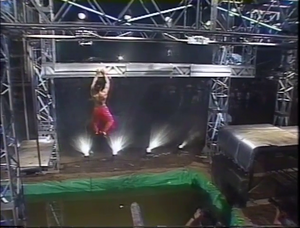
Akiyama Kazuhiko attempting Cliffhanger in SASUKE 4
Due to Akiyama Kazuhiko's Kanzenseiha in that tournament, it was replaced by Cliffhanger Dansa as part of making the course harder in the following tournament, despite the fact it eliminated five out of 10 competitors that attemped this version. Among those five competitors that failed this version are Kane Kosugi and Yamada Katsumi, the two favourites to achieve Kanzenseiha during the tournament.
Second Version
The full name as Cliffhanger Dansa (クリフハンガー段差, literally Cliffhanger with Dropout Section) is the second version of Cliffhanger, appearing from SASUKE 5 to SASUKE 8. The only modification from the previous version being the third ledge was raised by 30 cm, creating a "step" to be crossed by (Dansa means "Step" in Japanese). The length of the gaps remained at 50 cm.
Interestingly, the obstacle was initially named in SASUKE 5 as Cliffhanger (Kai) [クリフハンガー (改)], but for unknown reasons, it was reverted to the original naming in the next tournament. The successor version adopted the name afterwards.
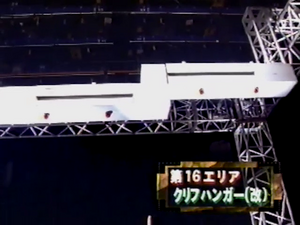
Cliffhanger being named as Cliffhanger (Kai) in SASUKE 5
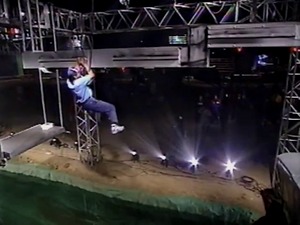
Yamamoto Shingo attempting Cliffhanger in SASUKE 5
Yamamoto Shingo was the only competitor to attempt this version more than once in SASUKE 5 and SASUKE 7 (both times clearing it). This version claimed at least one victim in two out of four tournaments in which it was used, with SASUKE 5 and SASUKE 8 being the tournaments with 100% clear rate, making it the first Cliffhanger version to have multiple tournaments with 100% clear rate.
This version was notable for being the only version to have been replaced without the impetus of a kanzenseiha until the introduction of the Cliffhanger Dimension.
Third Version
Cliffhanger Kai (クリフハンガー改, literally Altered Cliffhanger) is the third version of Cliffhanger, appearing from SASUKE 9 to SASUKE 17. The modifications compared to the previous version being the first ledge was doubled in length to 2.4 metres (despite it being 1.2 metres in blueprint), the second ledge was raised by 30 cm, and the third ledge was lowered by 45 cm. The length of the gaps still remained at 50 cm.
So far, this version lasted the longest thus far of any versions. In later tournaments, the obstacle marked the halfway point and clearing it was a major accomplishment.
Like Lamp Grasper which introduced in the same tournament, the distance of the obstacle to the finish platform varied from one tournament to another:
- In SASUKE 9, the platform was placed very far from the third ledge, so competitors were forced to traverse the entire length of the third ledge.
- In SASUKE 10, 11, and 13 to 17, the platform was placed slightly underneath the third ledge, so competitors could dismount after traversing around three-quarters of the third ledge's length.
- In SASUKE 12, the platform was placed slightly after the second gap, so competitors could dismount after touching the third ledge.
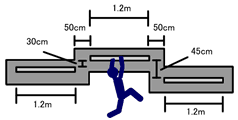
Cliffhanger Kai's blueprint. It showed all three ledges being the same length, rather than the first ledge being longer than the other two
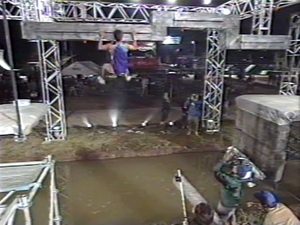
Shiratori Bunpei attempting Cliffhanger Kai
in SASUKE 12
This version was more deadly compared to the previous version, as from nine tournaments it was used, only SASUKE 9 ended up being the only tournament to had 100% clear rate (and in that tournament, it was only attempted by Nagano Makoto).
However, due to Nagano Makoto's Kanzenseiha, it will be replaced by Shin-Cliffhanger in SASUKE 18.
Fourth Version
Shin-Cliffhanger (新クリフハンガー) (literally New Cliffhanger) is the fourth version of Cliffhanger, appearing from SASUKE 18 to SASUKE 24. The modifications compared to the previous version being the second ledge shortened to 77 cm with an incline of twelve-degree (causing the length of the second gap changed for the first time from 50 cm to around 1 metre), the width for the third ledge's first part increased to 6 cm, and all ledges have been beveled to increase the difficulty.
Due to the large gap, in SASUKE 18, Nagano Makoto was disqualified when he attempt to jump to the third ledge. A metal sheet was placed above the first and third ledges starting from SASUKE 19 to prevent such case occured again.

Nagano Makoto attempting Shin-Cliffhanger in
SASUKE 18, but disqualify himself after grabbing the top of the obstacle
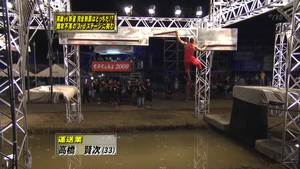
Takahashi Kenji attempting modified Shin-Cliffhanger in SASUKE 23
Seeing Nagano's failure before him, Nagasaki Shunsuke tried to cross the gap without jumping, however, he couldn't overcome the gap, making it seemed impossible for the competitors to clear the gap without jumping. However, in SASUKE 23 and 24, Takahashi Kenji was able to cross the gap without jumping, being the only one to do so.
This remain the version with the longest wait for a clear, as the first clear happened in SASUKE 21 by Takeda Toshihiro, a wait of four tournaments. However, in SASUKE 23 and 24, it surprisingly become much easier as competitors begin to understand how to clear it, with only Levi Meeuwenberg being the only victim of it during both tournaments (doing so in SASUKE 23, making him the only competitor to fail this version twice after doing so previously in SASUKE 20). Also, with two 100% clear rate in SASUKE 21 and SASUKE 24, this version become the second Cliffhanger version to have multiple tournaments with 100% clear rate.
Despite all of that, due to Urushihara Yuuji's Kanzenseiha, it was replaced by Ultimate Cliffhanger in SASUKE 25.
Fifth Version
Ultimate Cliffhanger (アルティメットクリフハンガー) is the fifth version of Cliffhanger, appearing from SASUKE 25 to SASUKE 27. A major overhaul was done compared to the previous version, with this version having six ledges instead of three. The length of the ledges and the gaps are as follows:
- Ledges
- First ledge's length is 2 metres and on a twenty four-degree angle, requiring competitors to climb diagonally to their right.
- Second ledge's length is 2 metres and on a twelve-degree angle, requiring competitors to climb diagonally to their left.
- Third ledge's length is 3.2 metres but being put without an incline, requiring competitors to traverse to their right.
- Fourth ledge's length is 1.2 metres but being put without an incline, requiring competitors to traverse to their right.
- Fifth ledge's length is 15 cm, the smallest from all six, requiring competitors to jump from the fourth ledge to grab it.
- Fifth ledge's length is 2 metres but being put without an incline, requiring competitors to traverse to their right.
- Gaps
- First gap's length is 20 cm vertically.
- Second gap's length is 60 cm vertically.
- Third gap's length is 90 cm horizontally.
- Fourth and fifth gap's length is unknown.

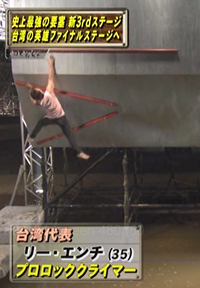

Comparison between Hashimoto Kouji, Lee En-Chih, and a tester when attempting the transition to the third ledge in SASUKE 25
In its first tournament, this version was proven to be unbelievably difficult, as all four competitors who attempted it failed before any could even reach the third ledge, though Hashimoto Kouji and Lee En-Chih got close. It was speculated that both of their failures were results of not trying to reach the end of the second ledge, as a tester was shown able to clear the gap after traversing the entire length of the second ledge.
Modification
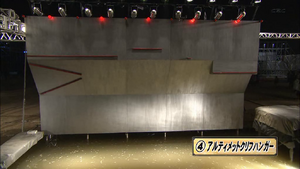
Modified Ultimate Cliffhanger in full, as seen in SASUKE 26
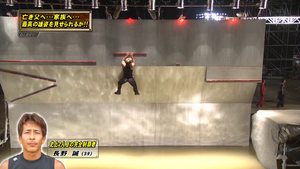
Nagano Makoto attempting Ultimate Cliffhanger in SASUKE 27
In SASUKE 26, the third ledge was lowered to make the transition from the angled ledges easier, but this resulted in making the transition to the fourth ledge much harder. To compensate for what would have been a 1.2 metre gap between the third and fourth ledges, the third ledge was also lengthened slightly to make it a gap more similar to the gap between the second and third ledges of the second version. Also, a large sheet of metal was placed at the base of the obstacle, in order to hide the metal supports that were visible in SASUKE 25.
Lee En-Chih and Okuyama Yoshiyuki, in their second attempts, made it to the end of the fourth ledge, but failed while building momentum to swing to the small fifth ledge. Two American competitors, Brent Steffensen and David Campbell, also able to attempt this, however, both of them failed while trying to make a transition to the fourth ledge.
In SASUKE 27, the obstacle was relocated to the third obstacle. This change proved to be essential, as it was finally conquered by Hashimoto Koji (in his second attempt), eventual finalist Matachi Ryo, and eventual two-time Champion Urushihara Yuuji (both having their first attempts at this version, the former impressively doing so on his first Third Stage's appearance). It was nearly cleared by David Campbell as well, but his grip gave out on the final ledge, just before he could reach the finish platform. This make him one of five victims in this tournament, with the other four being James McGrath, Ryan Stratis, Paul Kasemir, and Nagano Makoto (the only All-Star to attempt Ultimate Cliffhanger).
Due to the fact that Ultimate Cliffhanger had eliminated every American competitor who attempted it in SASUKE 26 and SASUKE 27, Ultimate Cliffhanger had earned its status as one of the most brutal obstacles for the American competitors.
However, due to Urushihara Yuuji's second Kanzenseiha, it will be replaced by Crazy Cliffhanger in SASUKE 28.
Sixth Version
Crazy Cliffhanger (クレイジークリフハンガー) is the sixth version of Cliffhanger, appearing from SASUKE 28 to SASUKE 31. Another major overhaul was done compared to the previous version, with this version now having four ledges instead of six previously used. The first three ledges was almost similar to Cliffhanger Kai, with the difference being the third ledge was at the same height as the first ledge as opposed to being 15 cm lower. However, the third ledge had been shortened to a point where the competitors couldn't reach landing platform from it. Opposite the third ledge was another wall with a fourth ledge that was 1.2 metres-long.
Competitors must make enough momentum and jump from the third to the fourth ledge (similar to Spider Flip) and only then they could transfer to the finish platform. Though mentioned since SASUKE 28, in SASUKE 31, the distance of the third to the opposing fourth ledge was shown on-screen to be 1.8 metres. However, unlike Shin-Cliffhanger and Ultimate Cliffhanger, the ledge that must be jumped onto was not wider than the other ledges, making the transition more difficult.
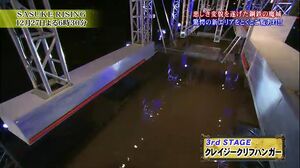
The distance between the third and fourth ledges as seen in SASUKE 28
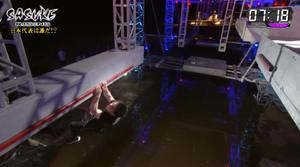
Morimoto Yūsuke attempting Crazy Cliffhanger in SASUKE 29
While grip and upper body strength played an important role in every Cliffhanger version, this version seemed to be based more on the weight of the competitors (rather than technique or stamina), due to the style of the last ledge transition. Also, unlike previous versions of Cliffhanger, in which competitors would eventually get the hang of the techniques required to clear the jump (most notably Shin-Cliffhanger), the jump on Crazy Cliffhanger was never truly mastered. This is largely due to the element of landing the jump, as competitors would succeed in doing the transition but would not have enough grip to hold on to the ledge. Even in its fourth and final appearance in SASUKE 31, only two out of eight competitors cleared.
In SASUKE 31, Drew Drechsel try to attempt the obstacle using uncoventional jump method in which he would turn to face the fourth ledge before attempting the jump. While succeeded, he was told that he was disqualified. After some arguments with the producers, he was granted a second chance, in which he would attempt the jump using conventional jump method that ended in failure. This tournament also saw Asa Kazuma's fourth consecutive failure at this version (the longest streak of failure on a Cliffhanger version, eventually tied by Satō Jun in SASUKE 36), Kanno Hitoshi finally clearing it at his fourth consecutive attempt (and being just the fifth competitor to clear), and Morimoto Yūsuke being the only competitor to clear this version twice (after previously doing so in SASUKE 29).
This version in overall was not cleared 18 times, which was the largest number of failures on any Cliffhanger version in SASUKE to date, even beating Cliffhanger Kai that appeared in more tournaments (it was not cleared 17 times).
Despite the difficulty, due to Morimoto Yūsuke's Kanzenseiha, it was replaced with Ultra Crazy Cliffhanger in SASUKE 32.
Seventh Version
Ultra Crazy Cliffhanger (ウルトラクレイジークリフハンガー) is the seventh version of Cliffhanger, appearing from SASUKE 32 to SASUKE 36, revealed via Inui's Twitter account, and then in SASUKE 32's Navi after Morimoto Yusuke's kanzenseiha. Compared to previous version, there are major differences, with the number of ledges being reduced to three, the catch is that competitors have to make two 1.8 metres transitions similar to the Crazy Cliffhanger, the second ledge curved inwards to increase the difficulty, and the third ledge is a moving ledge (first of such occasion in any Cliffhanger) that goes up and down by 90 cm. It was also tied together with Vertical Limit Kai without any break originally (before being changed in SASUKE 35) to make the second half of Third Stage more difficult as a whole.
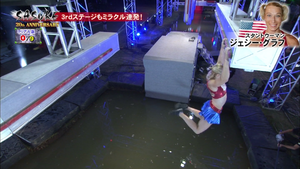
Jessie Graff attempting Ultra Crazy Cliffhanger in SASUKE 34
Similar to Crazy Cliffhanger, this version also based more on the weight of the competitor rather than technique or stamina due to the style of the ledge transitions. The timing is also crucial due to the transition to the moving ledge, making it very unpredictable which competitors sometimes glance at the moving ledge prior to transition. However, unlike the past three versions of Cliffhanger, this obstacle was successfully cleared in its introductory tournament, with Drew Drechsel managing to become the first competitor to clear it (although he immediately fail Vertical Limit Kai almost immediately due to lack of the break mentioned).
Unfortunately, no one managed to clear it in the next tournament, as Drew Drechsel, the only competitor to attempt it in that tournament, did the transition to the moving ledge one second too late (with the moving ledge starting to move up as he tried to make the transition), thus falling to the water. The number of attempts during the first two tournament were also noticeably smaller than the previous versions of Cliffhanger due to the presence of Flying Bar in the first half of Third Stage.
However, a larger number of competitors took on the obstacle in SASUKE 34 and it will proven itself a force to be reckoned with, eliminating a whopping six competitors out of seven, including Kawaguchi Tomohiro, Drew Drechsel (who failed the second transition yet again, this time one second too early), and Jessie Graff (who was the first woman to attempt Third Stage in SASUKE history). Only Morimoto Yūsuke was able to clear it in that tournament and again due to the lack of the break mentioned, he fail Vertical Limit Kai soon enough.
However, in SASUKE 35, three people were able to clear the obstacle, being Drew Drechsel (who became the first competitor to clear this version twice), Kawaguchi Tomohiro (who became the second competitor to clear Crazy Cliffhanger and Ultra Crazy Cliffhanger), and Morimoto Yūsuke (who became the only competitor to clear both Crazy Cliffhanger and Ultra Crazy Cliffhanger twice). Due to the green resting bar that was provided starting from this tournament, he would later clear Third Stage.
In SASUKE 36, another three competitors were able to clear the obstacle, being Tada Tatsuya (who became the fourth competitor to clear this version), Matachi Ryo (who became the third competitor to clear Crazy Cliffhanger and Ultra Crazy Cliffhanger, doing so in a very memorable attempt as he made a one-hand save when attempting the jump), and Urushihara Yuuji (who advanced to Third Stage for the first time since SASUKE 28). Morimoto once again clearing it in this tournament, becoming the only competitor to clear Ultra Crazy Cliffhanger three times in a row. Just like on the previous tournament, he would later become the only competitor to clear Third Stage in that tournament.
While the focus in this version is usually the second transition, few competitors also failed to clear the first transition, being Satō Jun (SASUKE 32, 34, and 35), Hioki Masashi, Jessie Graff (both SASUKE 34), and Kawaguchi Tomohiro (SASUKE 36). In addition, Anastase Ragivaru was notable for being the only competitor to attempt this version but didn't attempt the transition(s) due to him losing his grip on the first ledge.
Possibly due to this version gradually having more successes as the tournament progressed, Ultra Crazy Cliffhanger is replaced by Cliffhanger Dimension in SASUKE 37, making this the second Cliffhanger version to have been replaced without the impetus of a Kanzenseiha.
Eighth Version
Cliffhanger Dimension (クリフハンガーディメンション) is the eighth and current version of Cliffhanger, being introduced in SASUKE 37. It again receive major modifications compared to the previous version, with the second ledge now moving up and down, the third ledge was embedded on the Plexiglas board and moved forward and backward, and both the second and third ledges moved as its respective direction by 90 cm (however, in SASUKE 38, the second ledge moves by 1 metre, an increment of 10 cm from its debut tournament).
This version of the Cliffhanger, similar to Crazy Cliffhanger and Ultra Crazy Cliffhanger, is also based more on the weight of the competitor rather than technique or stamina due to the style of the ledge transitions. The timing is also crucial due to the transition to the moving ledge, making it very unpredictable which competitors sometimes glance at the moving ledge prior to transition.
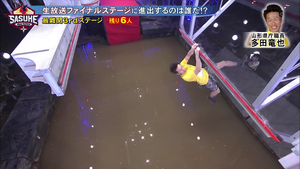
Tada Tatsuya attempting Cliffhanger Dimension in SASUKE 37
Like Ultra Crazy Cliffhanger, this version was successfully cleared in its introductory tournament, this time by Tada Tatsuya. This was due to the fact that in SASUKE 37, due to poor weather resulting the motors of the ledges malfunctioning, the ledges were stopped and adjusted to its respective height and distance around 1.8 metres, rendering the obstacle less difficult and brutal, eliminating the need to glance prior to transition to the moving ledge. However, based on Rene Kaselowsky's testimonial, he mentioned in a post-tournament interview that the ledges were halted due to the fact that the production team wanted at least one clear on Third Stage so that the live Final Stage could go ahead. Despite that, it was still proven to be a threat, as only three of the eight competitors could clear it. It took out notable competitors such as Hioki Masashi, Jessie Graff, and Satō Jun.
In SASUKE 38 however, is where the motors of the obstacle are finally fully functional, showing its true lethality. Both ledges moves at different speed, making transition even more crucial than it is before. This was proven by Tada, who failed the second transition. However, controversy arose before his run, as Yamamoto Yoshiyuki who was the first to attempt Cliffhanger Dimension in the tournament actually cleared both transitions, however, due to the soap that was not washed properly prior to his run, he slipped at the third ledge. Morimoto Yūsuke will later be the fourth competitor to clear this version and he would go on to not just clear Third Stage, but also achieve his second Kanzenseiha.
KUNOICHI Appearance
Cliffhanger (クリフハンガー) will then appeared in KUNOICHI, originally used as the sixth obstacle of BLUE Stage (Second Stage), however, it was relocated in KUNOICHI 2017 Summer as the fourth obstacle of BLACK Stage (Third Stage.
It originally was a toned-down version of the original Cliffhanger, featuring only two ledges (as it seemed like the first gap was removed to merge the first two ledges as one, making it being longer compared to the other ledge) and both ledges were increased to 4.5 cm in thickness. To compensate the toned-down difficulty, the gap between the ledges was increased to 60 cm. Also, the current logo of KUNOICHI was being visible below the first ledge.
However, due to the dominance of Sponge Bridge in the tournament, it was only attempted by Izumi Hikari, who was able to clear it easily.
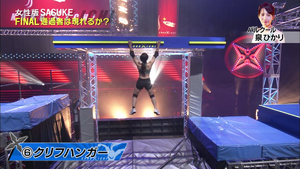
Izumi Hikari attempting Cliffhanger in KUNOICHI 2017 Spring
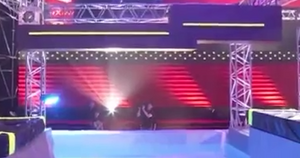
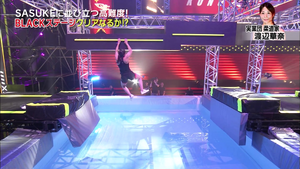
Watanabe Kana attempting modified Cliffhanger in KUNOICHI 2017 Summer
For unknown reasons, Cliffhanger was modified in the next tournament, decreasing the thickness of the ledges to 4 cm. Also, the second ledge was raised about 7 cm, making it seemed like a toned-down version of Cliffhanger Dansa.
It was attempted by three competitors, with AYA being the only one who failed, while Watanabe Kana and Izumi Hikari easily cleared it and went to Pipe Slider.
However, in the following tournament, it will be replaced by Planet Bridge.
Competitors' Success Rate
- All results based on the TBS broadcast and external information found
SASUKE
Cliffhanger
| SASUKE | Clears | Attempts | Percentage |
|---|---|---|---|
| 4 | 5 | 10 | 50% |
| Total | 5 | 10 | 50% |
Cliffhanger
| SASUKE | Clears | Attempts | Percentage |
|---|---|---|---|
| 5 | 1 | 1 | 100% |
| 6 | 1 | 2 | 50% |
| 7 | 1 | 3 | 33.33% |
| 8 | 3 | 3 | 100% |
| Total | 6 | 9 | 66.67% |
Cliffhanger Kai
| SASUKE | Clears | Attempts | Percentage |
|---|---|---|---|
| 9 | 1 | 1 | 100% |
| 10 | 1 | 2 | 50% |
| 11 | 2 | 4 | 50% |
| 12 | 5 | 9 | 55.56% |
| 13 | 2 | 3 | 66.67% |
| 14 | 2 | 5 | 40% |
| 15 | 3 | 4 | 75% |
| 16 | 3 | 7 | 42.86% |
| 17 | 3 | 4 | 75% |
| Total | 22 | 39 | 56.41% |
Shin-Cliffhanger
| SASUKE | Clears | Attempts | Percentage |
|---|---|---|---|
| 18 | 0 | 3 | 0% |
| 19 | 0 | 0 | N/A |
| 20 | 0 | 1 | 0% |
| 21 | 2 | 2 | 100% |
| 22 | 2 | 4 | 50% |
| 23 | 5 | 6 | 83.33% |
| 24 | 7 | 7 | 100% |
| Total | 16 | 23 | 69.57% |
Ultimate Cliffhanger
| SASUKE | Clears | Attempts | Percentage |
|---|---|---|---|
| 25 | 0 | 4 | 0% |
| 26 | 0 | 4 | 0% |
| 27 | 3 | 8 | 37.5% |
| Total | 3 | 16 | 18.75% |
Crazy Cliffhanger
| SASUKE | Clears | Attempts | Percentage |
|---|---|---|---|
| 28 | 0 | 3 | 0% |
| 29 | 1 | 4 | 25% |
| 30 | 3 | 9 | 33.33% |
| 31 | 2 | 8 | 25% |
| Total | 6 | 24 | 25% |
Ultra Crazy Cliffhanger
| SASUKE | Clears | Attempts | Percentage |
|---|---|---|---|
| 32 | 1 | 3 | 33.33% |
| 33 | 0 | 1 | 0% |
| 34 | 1 | 7 | 14.29% |
| 35 | 3 | 4 | 75% |
| 36 | 4 | 8 | 50% |
| Total | 9 | 23 | 39.13% |
Cliffhanger Dimension
| SASUKE | Clears | Attempts | Percentage |
|---|---|---|---|
| 37 | 3 | 8 | 37.5% |
| 38 | 1 | 4 | 25% |
| Total | 4 | 12 | 33.33% |
KUNOICHI
| KUNOICHI | Clears | Attempts | Percentage |
|---|---|---|---|
| 2017 Spring | 1 | 1 | 100% |
| 2017 Summer | 2 | 3 | 66.67% |
| Total | 3 | 4 | 75% |
Other Appearances
Cliffhanger
Australian Ninja Warrior
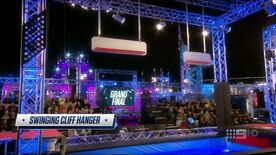
Australian Ninja Warrior 3's Swinging Cliff Hanger
A variation of this version of the Cliffhanger, called the Swinging Cliff Hanger, appeared as the fourth obstacle in Stage One on Australian Ninja Warrior 3.
The obstacle featured two ledges, each was attached to a swinging board (similar to the one used on the Swinging Peg Board). Therefore, after traversing the first ledge, competitors must build enough swing and momentum to make the transition to the second ledge, and then build enough swing and momentum from the second ledge to make the dismount to the landing platform.
Cliffhanger Kai
American Ninja Warrior

American Ninja Warrior 5's Cliffhanger in Venice Beach
This version appeared as the ninth obstacle on American Ninja Warrior 5 during Venice Beach finals, eliminating 6 out of 12 competitors who attempted it (likely due to fatigue after completing the previous obstacle, the Rope Maze), including Brian Kretsch, Dan Mast, Lance Pekus, Jesse La Flair, and Justin Walker.
SASUKE Vietnam
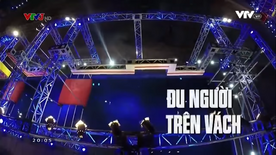
SASUKE Vietnam 2's Cliffhanger Kai
Treo Người Trên Vách or Đu Người Trên Vách (SASUKE Vietnam's official name for the Cliffhanger Kai) appeared as the fifth obstacle in Stage 3 on SASUKE Vietnam 1 and SASUKE Vietnam 2. However, unlike in SASUKE, after reaching the end of the third ledge, competitors must grab a resting bar, as an intermediary to the next obstacle (the Pipe Slider).
On SASUKE Vietnam 1, the obstacle eliminated 4 out of 5 competitors who attempted it (including Nguyễn Phước Huynh, Đỗ Văn Quang, Nguyễn Đức Thọ and Lê Văn Đại). Lê Văn Thực was the first competitor to beat the obstacle.
On SASUKE Vietnam 2, it was notable for eliminating some top competitors like Nguyễn Đức Thọ, Trần Văn Anh, and Brian Kretsch. Nevertheless, 14 competitors were able to complete the obstacle.
With the total victories of Lê Văn Thực, Nguyễn Phước Huynh, and David Campbell on SASUKE Vietnam 2, the Cliffhanger Kai was replaced by the Crazy Cliffhanger the next season, following the tradition in which the course would be modified after a total victory was achieved.
Shin-Cliffhanger
SASUKE Ninja Warrior Indonesia
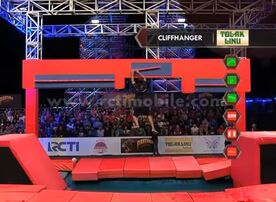
SASUKE Ninja Warrior Indonesia's Cliffhanger in Final Stage
On SASUKE Ninja Warrior Indonesia the Shin-Cliffhanger appeared as the fourth obstacle during Final Stage (although it was simply called as the Cliffhanger). Among the 10 competitors who attempted it, six of them could complete it, while the other four competitors failed to make the transition to the third ledge.
Ultimate Cliffhanger
Ninja Warrior UK and Sweden
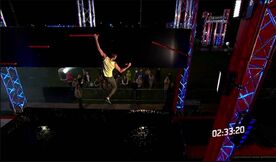
Alexander Mars on the Cliffhanger, Ninja Warrior Sweden
On Ninja Warrior UK and Ninja Warrior Sweden, a variant of the obstacle (unofficially named as the Miska Cliffhanger) has appeared.
This version featured radically different ledges placement compared to the SASUKE and American Ninja Warrior versions, with a greater emphasis on diagonal ledges and long jumps.
No one has attempted this version on Ninja Warrior UK and Ninja Warrior UK 2, due to being replaced by the Crazy Cliffhanger (American Ninja Warrior 7 version) on Ninja Warrior UK 3, although Alexander Mars failed there on Ninja Warrior Sweden.
SASUKE Ninja Warrior Indonesia
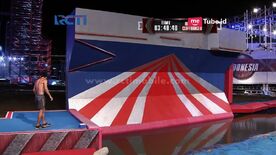
SASUKE Ninja Warrior Indonesia 2017's Ultimate Cliffhanger in Final Stage
On SASUKE Ninja Warrior Indonesia 2, the Ultimate Cliffhanger appeared as the fifth and penultimate obstacle during Final Stage, with the following specification:
- The obstacle's wall was the same as American Ninja Warrior 7 version of the Ultimate Cliffhanger, except there was no leap transition to the final ledge at the hanging board.
- There were seven ledges, with the first five ledges were similar to the first fice ledges from SASUKE 26-27 version of the Ultimate Cliffhanger, and the last two ledges were similar to the last two ledges (excluding the final ledge at the hanging board) from American Ninja Warrior 7 version of the Ultimate Cliffhanger.
- After reaching the end of the seventh ledge, competitors must grab the resting bars, as an intermediary to the sixth and final obstacle, the Flying Bar.
Among the two competitors who attempted the obstacle (Yosua Laskaman Zalukhu and Angga Cahya), both of them could complete it. Also, during SASUKE Ninja Warrior Indonesia: International Competition, no competitor failed on this obstacle.
American Ninja Warrior
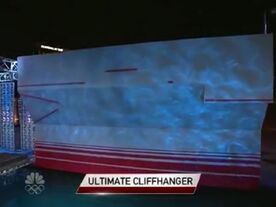
American Ninja Warrior 4's Ultimate Cliffhanger in Stage Three
On American Ninja Warrior 4, the Ultimate Cliffhanger appeared as the fourth obstacle in Stage Three, with the same specification from SASUKE 26-27. Brent Steffensen, who himself failed there in SASUKE 26, became the first American to beat the Ultimate Cliffhanger.
On American Ninja Warrior 5, Brian Arnold became the second American to beat the Ultimate Cliffhanger, and nearly beating Stage Three.
During USA vs. Japan, Paul Kasemir (who failed on this obstacle in SASUKE 27) from Team USA became the third American to beat the Ultimate Cliffhanger, also nearly beating Stage Three. On the other hand, Kanno Hitoshi from Team Japan failed to make the transition to the fifth ledge.
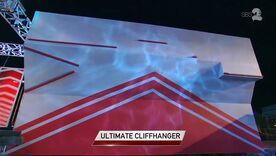
American Ninja Warrior 5's Ultimate Cliffhanger in Stage Three
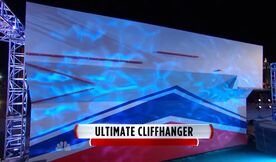
American Ninja Warrior 6's Ultimate Cliffhanger in Stage Three
On American Ninja Warrior 6, the ledges were made much thicker. Instead of being 1.18 inches (3cm) as they had been in SASUKE and two previous American Ninja Warrior seasons, they were increased to 2.25 inches (5.7cm) in thickness (later seasons were decreased to 2 inches (5.08cm)), making the obstacle much easier. Also, the fourth ledge was made longer, making the gap between the third and fourth ledge was smaller. As the result, Joe Moravsky became the fourth American to beat the Ultimate Cliffhanger and just the third to complete it on American Ninja Warrior's regular season.
During USA vs. The World, all seven competitors who attempted the obstacle were able to complete it.
Modification
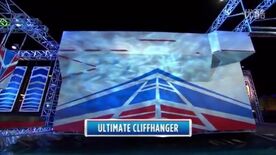
American Ninja Warrior 7's Ultimate Cliffhanger in Stage Three
On American Ninja Warrior 7, the obstacle was heavily modified:
- The first three ledges were positioned identically from the previous season, but now had gaps in between them.
- The fourth and fifth ledges remained the same, with the fourth ledge was placed much higher.
- After the fifth ledge, there were two ledges, which were placed equally high as the fifth ledge, and it was now impossible to reach the landing mat from the seventh ledge.
- Instead, similar to the Crazy Cliffhanger, competitors would have to jump 6 feet from the seventh ledge to the final ledge at the hanging board, facing opposite to the main wall, which was 2 inches wide as opposed to only 1 inch. And from there, they were able to reach the landing platform.
However, unlike the Crazy Cliffhanger, competitors were allowed to face the final ledge when making the transition (as the controversial rule was not established). Even so, the obstacle caused havoc, as half of the remaining competitors in Stage Three was eliminated on this obstacle, including Joe Moravsky (who had completed the obstacle on the previous season), who chose the Crazy Cliffhanger technique for leap transition to the final ledge. Despite that, 4 competitors were able to complete this obstacle, which was the largest number of the Ultimate Cliffhanger's completion during American Ninja Warrior's regular season until American Ninja Warrior 11, where a large amount of competitors attempted it due to the sheer amount of Stage Two clears on that season. As the result, Ian Dory, Isaac Caldiero, Drew Drechsel, and Geoff Britten became the fifth, sixth, seventh, and eighth Americans to beat it, with seven Americans completed it on American Ninja Warrior's regular season.
During USA vs. The World 2, the obstacle took out two competitors: Alexander Mars from Team Europe and Joe Moravsky from Team USA (who fell on this version for the second time). On the other hand, Ian Dory, Matachi Ryo, Stefano Ghisolfi, Morimoto Yūsuke, Sean McColl, and Isaac Caldiero could complete it.
Second Modification
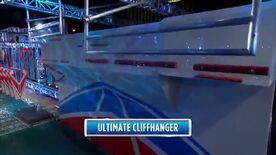
American Ninja Warrior 8's Ultimate Cliffhanger in Stage Three
On American Ninja Warrior 8, with total victories of Geoff Britten and Isaac Caldiero on the previous season, the obstacle was once again modified:
- The first four ledges were the same as the Ultimate Cliffhanger from American Ninja Warrior 7, with the fourth ledge was placed slightly higher.
- Under the fourth ledge, there was a small ledge as a foothold, in order to ease the ledge transition to the first hanging board, making this transition similar to the Spider Flip.
- After that, competitors must make a transition to the next ledge (second hanging board).
- And finally, they must transit back to the final ledge opposite to the hanging board, and dismount to the landing platform.
Making this version of Ultimate Cliffhanger was similar to the Ultra Crazy Cliffhanger and Cliffhanger Dimension, with two ledge transitions across the water. Also, the design of the wall in the obstacle was similar to the wall used in the Half Pipe Attack on American Ninja Warrior 6, albeit the color and location of the design. Only Drew Drechsel completed the obstacle, while Daniel Gil failed the transition to the second hanging board.
During USA vs. The World 3, the obstacle shockingly took out 3 highly-skilled rock climbers (Stefano Ghisolfi from Team Europe, David Saikin from Team Latin America, and Brian Arnold from Team USA), and all of them competed on the same heat of Stage Three, in which:
- Stefano Ghisolfi failed to make the transition to the fourth ledge,
- David Saikin failed to make the transition to the second hanging board, and
- Brian Arnold completed all the ledges, but failed to make the dismount to the landing platform.
However, since Stefano Ghisolfi completed the previous obstacle (the Floating Boards) faster than David Saikin and Brian Arnold, he won the 3 points for Team Europe.
On the other hand, Josh Levin from Team USA became the ninth American to beat the obstacle. Also, Santiago de Alba, Alexander Mars (who failed on this obstacle during the previous tournament), Diego Gonzalez, Sean McColl, and Drew Drechsel could complete it as well.
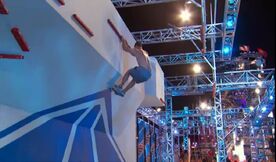
Joe Moravsky was about to attempt the first transition of the Ultimate Cliffhanger during American Ninja Warrior 9's Stage Three
On American Ninja Warrior 9, the same version of the Ultimate Cliffhanger from the previous season appeared, with minor modification for the ledges at the two hanging boards. Only Joe Moravsky could complete the obstacle, even using the Crazy Cliffhanger technique on the transition to the final ledge (which he failed to complete on American Ninja Warrior 7), while Sean Bryan and Najee Richardson failed on the transition to the fourth ledge and the second hanging board respectively.
During USA vs. The World 4, the Ultimate Cliffhanger became much brutal than ever, as the obstacle eliminated every competitor who attempted it. Among the 5 competitors who attempted the obstacle, 3 of them failed to make the transition to the second hanging board (Drew Drechsel, Sergio Verdasco, and Alexander Mars), while the other 2 competitors failed to make the transition to the fourth ledge (Sebastian Prieto and Joe Moravsky).
Third Modification
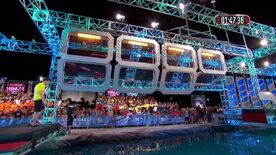
American Ninja Warrior 10's Ultimate Cliffhanger in Stage Three
On American Ninja Warrior 10, several changes were made to the Ultimate Cliffhanger:
- the obstacle's wall was now composed by Plexiglas walls,
- there were more ledges and some minor changes for the ledges' placement,
- the two hanging boards were now much closer to each other, compared to the past two American Ninja Warrior seasons.
This time, the obstacle became much brutal once again, as among the two competitors who attempted the obstacle, both of them failed to complete it: Sean Bryan and Drew Drechsel. Those two were also the only competitors who advanced to Stage Three. Because of this, the decision of who became the Last Man Standing of the season was determined by the competitor who completed the previous obstacle (the Crazy Clocks) in the fastest time. Since Drew Drechsel was the competitor to do so, he was then declared as the Last Man Standing of the season and won the $100,000 cash prize. This is noted to be the only version of the Ultimate Cliffhanger that was not completed in the regular season since the inception of the National Finals in Las Vegas on American Ninja Warrior 4.
During USA vs. The World 5, Drew Drechsel from Team USA became the first to complete it this year. On the other hand, Ben Polson from Team Australia fell halfway through the obstacle.
Fourth Modification
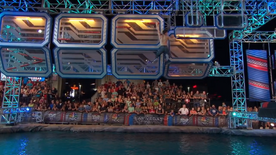
American Ninja Warrior 11's Ultimate Cliffhanger in Stage Three
On American Ninja Warrior 11, the modification of the Ultimate Cliffhanger used on American Ninja Warrior 7 returned, with competitors having to do one ledge transition instead of two. The Plexiglas remained from the previous season, albeit with a visual design which made some parts of the glass opaque. Compared with the previous season:
- The foothold was removed.
- Some minor changes for the ledges' placement, albeit some of them were retained.
- Instead of transiting to another set of Plexiglas, competitors must transit to the first hanging board, possibly due to an erroneous in design.
- All of the hanging boards were placed lower and shortened, each only had one ledge.
- Once competitors are in the first hanging board, they would do the ledge transition to the second hanging board which is opposite the first.
- The length of the second hanging board was very short, with the ledge being similar to the fifth ledge on the original Ultimate Cliffhanger.
- Competitors had to make the dismount from the third hanging board.
A total of 17 competitors attempted this version, and due to these changes, only six competitors failed on it. A unique way to fail on the obstacle was presented when three competitors (Hunter Guerard, Michael Torres, Ethan Swanson), both were running out of stamina and couldn't make a successful dismount from the third hanging board (somewhat similar to what happened with Brian Arnold during USA vs. The World 3). The three others, two failed on the jump to the second hanging board (Chris DiGangi, Casey Suchocki), and Mathis Owhadi failed on the transition to the third hanging board. With that in mind, 11 competitors completed the obstacle, which broke the record of the most completion during American Ninja Warrior's regular season on American Ninja Warrior 7 (at four competitors). As the result, Lucas Reale, Tyler Gillett, Karsten Williams, Tyler Smith, Seth Rogers, Kevin Carbone, Karson Voiles, Adam Rayl, and Daniel Gil (who failed on this obstacle on American Ninja Warrior 8) became the tenth to the eighteen Americans respectively to beat it, with the fact that sixteen Americans complete it on American Ninja Warrior's regular season.
During USA vs. The World 6, all three competitors who attempted the obstacle were able to complete it.
Crazy Cliffhanger
American Ninja Warrior
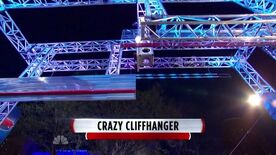
American Ninja Warrior 6's Crazy Cliffhanger in St. Louis

American Ninja Warrior 7's Crazy Cliffhanger in Houston
The Crazy Cliffhanger appeared on American Ninja Warrior 6, as the ninth obstacle during St. Louis finals. However, unlike in SASUKE, instead of three ledges going to the right then having to jump to the other side, there was one ledge going to the right and two small ledges to help getting to the other ledge. This version of the Crazy Cliffhanger was proven to be much easier than in SASUKE, as among the 12 competitors who attempted the obstacle, only 3 of them failed to complete it.
Then, the Crazy Cliffhanger returned on American Ninja Warrior 7, as the ninth obstacle during Houston finals. This time, the obstacle was looked almost similar to the Crazy Cliffhanger from SASUKE, but the number of ledges was increased from four to six, with the first five ledges being on one side, and the sixth ledge being on the opposing side.
Competitors could also face the opposing ledge when making the transition (unlike in SASUKE, where competitors were not allowed to do it, as the controversial rule was not established). The distance between the fifth and sixth ledges was 4 feet. Among the 5 competitors who attempted the obstacle, only 2 of them could complete it (Jeremiah Morgan and Sam Sann).
Ninja Warrior UK

Ninja Warrior UK 4's Crazy Cliffhanger
The Crazy Cliffhanger appeared as the first obstacle during the finals' Stage 3 on Ninja Warrior UK 3 and Ninja Warrior UK 4, which was very similar to the one used during American Ninja Warrior 7's Houston finals (except there were five ledges instead of six, with the first four ledges being on one side and the fifth ledge being on the opposing side).
On Ninja Warrior UK 3, two competitors (Cain Clarke and Jonny Urszuly) attempted the obstacle, but none of them could complete it. With Jonny Urszuly making the furthest to the obstacle than Cain Clarke, he then earned the title as the "Last Man Standing" on that season.
On Ninja Warrior UK 4, five competitors attempted the obstacle, and Deren Perez and Tim Shieff became the first 2 competitors to complete it. Ninja Warrior UK 5 also saw 2 competitors completed the Crazy Cliffhanger: Ali Hay and Tim Champion (who would later become the first ever competitor in Ninja Warrior UK history to achieve total victory and earn the title of the first "Ninja Warrior UK" on that season).
Australian Ninja Warrior
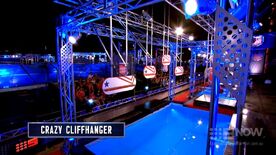
Australian Ninja Warrior 2's Crazy Cliffhanger
The Crazy Cliffhanger appeared:
- as the sixth obstacle in Stage Two on Australian Ninja Warrior, and
- as the third obstacle in Stage Three on Australian Ninja Warrior 2 to Australian Ninja Warrior 4.
The Crazy Cliffhanger appeared on the first three seasons was similar to the Ninja Warrior UK version.
During the first two seasons, the obstacle was unattempted. On Australian Ninja Warrior 3, the obstacle was attempted for the first time ever by four competitors (Josh O'Sullivan, Bryson Klein, Daniel Mason, and Charlie Robbins) and all of them could complete it.
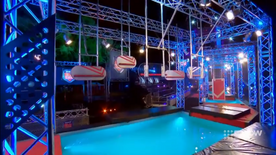
Australian Ninja Warrior 4's Crazy Cliffhanger
On Australian Ninja Warrior 4, several changes were made to the Crazy Cliffhanger. The obstacle still featured five ledges. But this time, the third and fourth ledges were placed on the other side of the obstacles, making it similar to the Ultimate Cliffhanger used from American Ninja Warrior 8 onwards, the Ultra Crazy Cliffhanger, and the Cliffhanger Dimension (all versions of the Cliffhanger featured two transitions across the water). Despite those changes, no competitor fell on the obstacle once again.
SASUKE Vietnam

SASUKE Vietnam 3's Crazy Cliffhanger
With the total victories of Lê Văn Thực, Nguyễn Phước Huynh, and David Campbell on SASUKE Vietnam 2, starting on SASUKE Vietnam 3, a new version of the Cliffhanger was introduced in order to replace the Cliffhanger Kai (called locally as Treo Người Trên Vách) from the past two SASUKE Vietnam seasons. It was the Crazy Cliffhanger (called locally as Treo Người Trên Vách Kép or simply called as Vách Kép), which appeared as the fifth obstacle in Stage 3 (later was moved to the sixth obstacle on SASUKE Vietnam 5), However, unlike in SASUKE or American Ninja Warrior, after reaching the end of fourth ledge, competitors had to grab a resting bar, as an intermediate to reach the next obstacle (the Flying Bar). The concept of the numbering for the Wall Lifting was applied, with the ledges being labeled in number 1 to 4. Also, the third ledge was made longer than the Crazy Cliffhanger used in SASUKE.
On SASUKE Vietnam 3, only Mat Redho attempted this obstacle, but failed while making the leap transition to the final ledge.
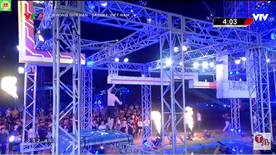
SASUKE Vietnam 4's Crazy Cliffhanger
On SASUKE Vietnam 4, the obstacle was modified. Due to the third ledge was made longer than the one used in SASUKE, there was a red sticker at the end of the third ledge, in which competitors were allowed to make the leap transition to the fourth ledge if they had reached the red sticker. Three competitors (Đỗ Văn Quang, Nguyễn Doãn Thọ, and Mat Redho) attempted the obstacle, but all of them failed while making the leap transition to the fourth ledge, making the Flying Bar once again was left unattempted.
On SASUKE Vietnam 5, due to the difficulties from the returning obstacles Pipe Slider and Hang Climbing, no competitor could reach this obstacle. This marked the first time that no one could attempt a version of the Cliffhanger in SASUKE Vietnam history.
Despite no competitor completed the Crazy Cliffhanger during the regular season so far, some competitors had completed the Crazy Cliffhanger on SASUKE Vietnam's international competition like SASUKE Vietnam: International Competition 2018 or SASUKE Vietnam: All-Stars Competition 2019.
Competitors' Success Rate
- All results based on the NBC broadcast and external information found
American Ninja Warrior
Ultimate Cliffhanger
| ANW | Clears | Attempts | Percentage |
|---|---|---|---|
| ANW4 | 1 | 1 | 100% |
| ANW5 | 1 | 1 | 100% |
| ANW6 | 1 | 1 | 100% |
| ANW7 | 4 | 8 | 50% |
| ANW8 | 1 | 2 | 50% |
| ANW9 | 1 | 3 | 33.33% |
| ANW10 | 0 | 2 | 0% |
| ANW11 | 11 | 17 | 64.71% |
| USA vs. Japan | 4 | 5 | 80% |
| USA vs. The World | 7 | 7 | 100% |
| USA vs. The World 2 | 6 | 8 | 75% |
| USA vs. The World 3 | 6 | 9 | 66.67% |
| USA vs. The World 4 | 0 | 5 | 0% |
| USA vs. The World 5 | 1 | 2 | 50% |
| USA vs. The World 6 | 3 | 3 | 100% |
| Total | 55 | 85 | 65% |
Crazy Cliffhanger
| ANW | Clears | Attempts | Percentage |
|---|---|---|---|
| ANW6 | 9 | 12 | 75% |
| ANW7 | 2 | 5 | 40% |
| Total | 11 | 17 | 64.71% |
Gallery
| ||||||||||||||||||||
| |||||||||||||||||||||||||||||

